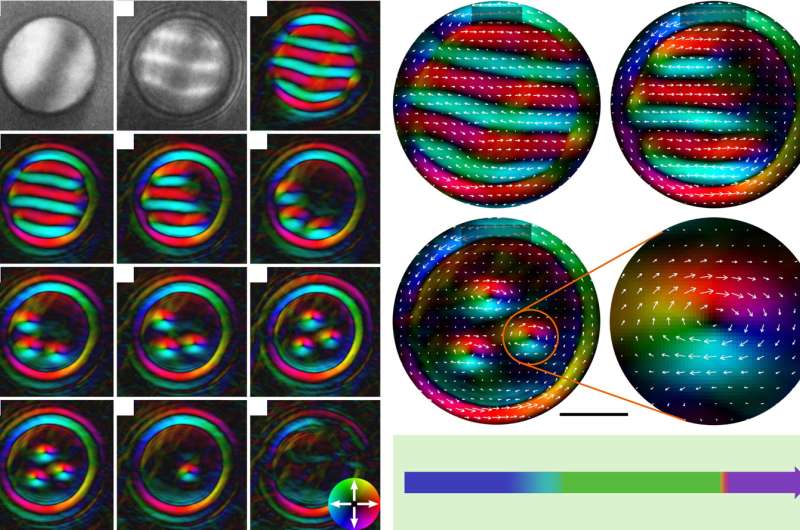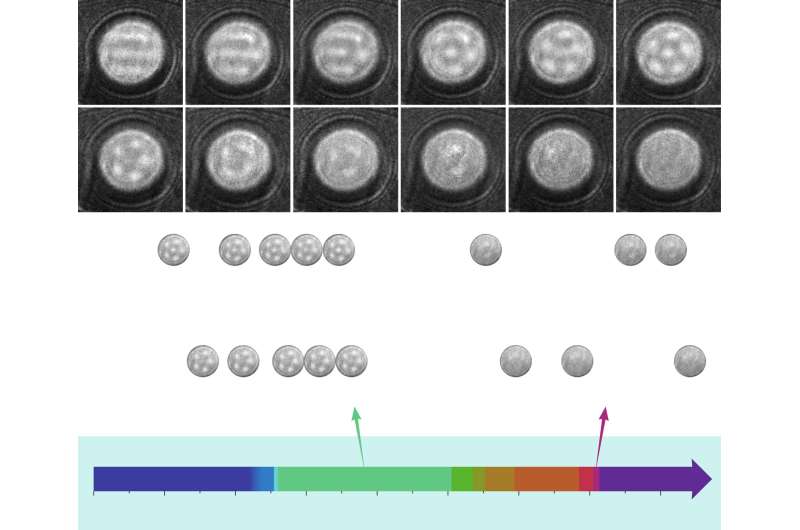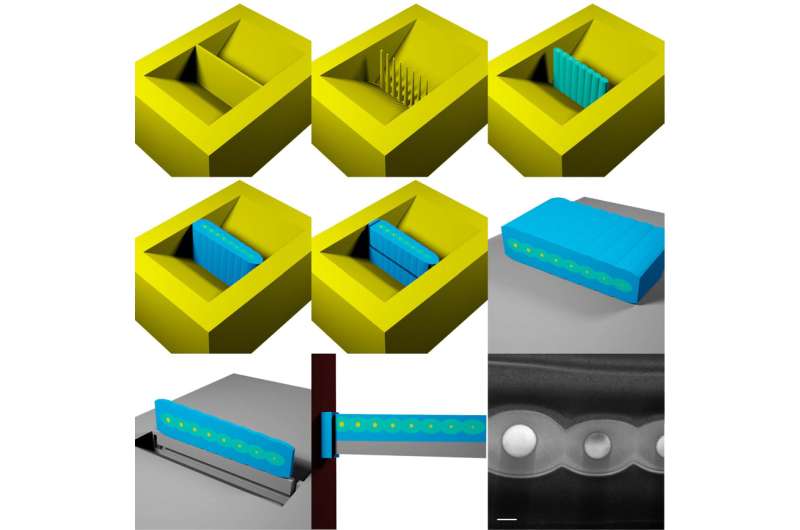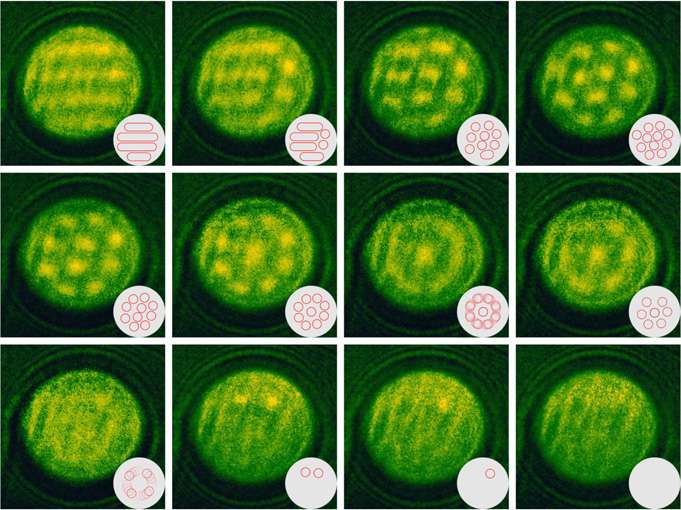May 26, 2016 feature
Scanning for skyrmions: Scientists directly image skyrmion cluster state transitions in iron-germanium nanodisks

Magnetic skyrmions, or noncoplanar swirling spin textures, are particle-like spin configurations with an integer topological charge that promise faster, denser memory storage. The hurdle to overcome in creating such devices is being able to understand single skyrmions in patterned nanoelements – but despite theoretical progress, real-world experimental studies of these entities have remained elusive. Recently, however, scientists at Chinese Academy of Science, Hefei, Fudan University, Shanghai, Nanjing University, Nanjing, and University of New Hampshire, Durham have demonstrated the direct visualization of skyrmion cluster states having different geometrical configurations in iron-germanium nanodisks. (Iron-germanium, or FeGe, is a complex alloy whose magnetic properties can vary considerably at nanoscale dimensions.) The researchers conclude that their results have an immediate implication for designing future skyrmion-based devices.
Prof. Mingliang Tian (Chinese Academy of Science) and Prof. Renchao Che (Fudan University) discussed the paper that they and their colleagues published in Proceedings of the National Academy of Sciences. One of the main challenges the team encountered, Tian tells Phys.org, was demonstrating the direct visualization of skyrmion cluster states of in nanodisks fabricated from iron-germanium. The scientists accomplished this, he adds, by using high-resolution Lorentz transmission electron microscopy to report the magnetic field-driven dynamics of individual skyrmions in nanodisks with diameters on the order of several skyrmions. "Real-space imaging of skyrmions is essential for addressing the dynamic behaviors of individual skyrmions," he explains. "However, the real implementation is highly challenging because of limitations in spatial resolution, sensitivity and the edge effect of the nanostructure on the recorded contrast of Lorentz transmission electron microscopy." Lorentz transmission electron microscopy (LTEM) is used to study a material's magnetic domains by imaging the deflection of electrons caused by the Lorentz force in magnetic fields. "The latter issue seriously affects the visualization of individual skyrmions in nanostructures with sizes below 200 nm due to the presence of Fresnel fringes, formed at the edge of the nanostructure," adds Prof. Renchao Che, director of Fudan University's LTEM lab. "This is because LTEM imaging requires an out-of-focus condition that causes the Fresnel fringes to smear out the recorded magnetic signal in the vacuum/sample interface."
As described in the paper, Tian's team members and co-authors, Dr. Haifeng Du and doctoral student Chiming Jin, developed a technique to reduce the interfacial Fresnel fringes in the Lorentz TEM images by using a focused ion beam (FIB) to encircle the outer size-tunable nanodisks with a layer of amorphous platinum-carbon alloy (PtCx). "This significantly reduced the size range of the artificial magnetic contrast," Tian explains, "thus leading to the direct image of the skyrmion cluster states in 100 nm scale disks."

Another issue the researchers encountered was determining the relationship between temperature, magnetic field, and disk size. "The real challenge in building this relationship comes from nanofabricating small disk samples," Tian notes. "We address this by using a top-down method to directly and controllably fabricate varied-size nanodisks." He adds that their results contrast significantly with the current expectations in bulk or two-dimensional films, where the skyrmions form closely-packed lattice arrangements. "We found that, at low temperatures – below ~200 Kelvin for FeGe nanodisks – the skyrmions form cluster states with maximum skyrmion number proportional to the disk diameter. This differs from skyrmion lattices at higher temperatures with the maximum skyrmion numbers proportional to the square of the disk diameter." Moreover, he adds, the magnetic field transition interval of skyrmion cluster states decreases with ascending temperature. "I was very excited when I directly observed, for the first time, the cascading transition and the fluctuations of skyrmion cluster states driven by the magnetic fields."
While LTEM is a powerful tool for imaging magnetic structures with nanometer-scale resolution, and has been used to image skyrmions by Dr. Xiuzhen Yu1, Tian notes that direct imaging of individual skyrmions in nanodisks with a size on the order of ~ 100 nm is still challenging due to the influence of Fresnel fringes at the sample edge. "By utilizing a top-to-down method with FIB technique, we fabricated nanodisks of various diameters from bulk FeGe enclosed with amorphous PtCx composite in order to enhance the mechanical strength and thereby precise manipulation of the nanodisk. "We're very lucky that edge coating with conducting PtCx composites was found to greatly weaken the Fresnel fringes near the edge boundary, and that by so doing enables us to extract the magnetic information in nanodisks smaller than 180 nm."
The scientists state that the team's results have immediate implication for designing future skyrmion-based devices, such as multibit memory cells. "We give the direct proof that single skyrmion can exist in nanostructured elements," Tian says. "Given the similarity between the skyrmions and magnetic vortices in soft magnetic nanodisks, the observed individual skyrmions will provide a viable alternative to spin-torque vortex-oscillator devices, and be a potential candidates for microwave signal-processing applications."

The paper points out that the theory-predicted target skyrmion in chiral magnets was not observed in the present experiment due to weak magnetic contrast and Fresnel fringes. "Target skyrmions, a concentric helicoidal undulation predicted previously by Dr. Du, may spontaneously exist in small size nanodisks without an external magnetic field, which is more suitable to skyrmion-based devices," Tian tells Phys.org. "It shows that target skyrmion stability will increase as nanodisk size decreases. However, at sizes below 100 nm, the weak artificial contrast from the edge will diffuse the real magnetic structure though the PtCx coating, and so significantly reduce the edge effect. Therefore, to realize the observation of target skyrmions, other magnetic microscopy techniques such as electron holography should be considered to avoid Fresnel fringe interference."
Moving forward, says Tian, by cooperative research between his nanomagnet physical properties team and Che's structural characterization team, the researchers will target several important issues in future, including searching for target skyrmions by varying disk size, thickness or other conditions by using electron holography, as previously noted; studying the current-driven motion of skyrmions in confined geometries; performing manipulation and electrical detection of skyrmions; and developing new techniques to fabricate nano-sized samples that are more controllable and more efficient for large-scale production.
In closing, Tian tells Phys.org that other areas of might research benefit from their study. "The techniques used in our study, such as our focused ion beam patterned procedure and transport intensity equation analysis, can be applied to other micromagnetics research. Moreover, since skyrmions have many features in common with Abrikosov vortices in superconductors, our results may provide some inspirations in this field."

More information: Direct imaging of magnetic field-driven transitions of skyrmion cluster states in FeGe nanodisks, PNAS May 3, 2016, vol. 113 no. 18 4918-4923, doi:10.1073/pnas.1600197113
Related
1Real-space observation of a two-dimensional skyrmion crystal, Nature 465, 901–904 (17 June 2010), doi:10.1038/nature09124
Journal information: Proceedings of the National Academy of Sciences , Nature
© 2016 Phys.org. All rights reserved.


















